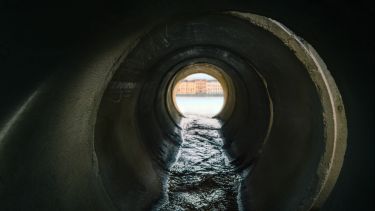Sensors
Acoustic (sound) waves provide an excellent opportunity to measure non-invasively the conditions of pipes, open channels and various types of underground infrastructure.

Sound waves propagate in spaces which are difficult or impossible to access and in which radio-frequency or light waves struggle to propagate. A good understanding of the conditions of urban water systems can be attained with better acoustic sensor technologies.
The level of understanding which these technologies can provide enables the water industry and environmental engineers to manage more efficiently and proactively the urban water resources and infrastructure to prevent their failures and flooding incidents.
Since its establishment, the Pennine Water Group was heavily involved in research related to acoustic sensors and wireless communication technology. This work was supported by a number of grants from the Engineering and Physical Sciences Research Council, including the platform grant EP/I029346/1, Royal Society and through the water industry funding.
The Group had an excellent set of complementary expertise in theoretical and experimental acoustics, fluid mechanics, signal processing and sensor design. The Group had excellent hydraulic and acoustic facilities for laboratory and field experiments in pipes and open channels. These facilities were used to develop and validate new theoretical and numerical models and test new instrument prototypes.
The Group had an excellent track record in working with non-academic partners on the dissemination and commercialisation of the results of their research.
Key people:
-
Kirill Horoshenkov, Acoustics & Signal Processing
-
Simon Tait, Hydraulics
-
Joby Boxall, Water Infrastructure Engineering
-
Anton Krynkin, Mathematics
Acoustic guided waves and transients in underground pipes
The propagation of acoustic waves in sewers and clean water distribution pipes is a highly challenging topic for research.
The complexity of this environment and unpredictability of the conditions which may exist in buried pipes complicates significantly the development of a robust theoretical basis for acoustic wave propagation. Therefore, our research are focused on a better understanding how a change in the conditions in underground pipes affect the acoustic waves, development of improved measurement methods and instrumentation which are capable of detecting and locating this change, and new signal processing and classification methods which can be used to assess the type and severity of this change from available acoustical information.
Acoustic scattering by the dynamically rough surface of an open channel flow
The presence of a porous matter such as soil, gravel, wall incrustation, fungal growth and various types of debris affects significantly the way acoustic waves propagate and attenuate. Therefore, our research is focused on the development and application of new theoretical and numerical models which relate the characteristics of porous matter with the resultant acoustic field. In this way, the amount of the porous matter and its properties can be measured remotely without the need for visual inspection.
Some of the important characteristics which can be measured with this acoustic technology include the porosity, permeability, pore size distribution and amount of porous deposit. The applications include the remote and rapid inspection of drainage pipes, underground chambers, storage tanks, water filtration equipment and sediment screens.
The key challenges here are the plurality of conditions which can exist in the buried infrastructure and the ability to develop a representatively theoretical model with which these conditions can be modelled accurately and interpreted correctly.
Acoustic scattering by the dynamically rough surface of an open channel flow
The accurate measurement of the velocity and depth of an open channel flow is very important information which is needed to estimate the discharge of fluid and the direction of the water flow. This information is essential for accurate prediction of flooding incidents, efficient and safe operation of water treatment plants, real-time control of underground sewer networks and controlling water pollution incidents.
Surprisingly, there are very few methods which are able to measure efficiently, non-invasively and in real-time the flow velocity and depth in an open channel flow. Therefore, our research is focused on the development of novel, high fidelity methods and instruments which make use of information on scattering and reflection of sound waves from the dynamically rough surface of a turbulent, open channel flow.
The main research questions here is how to relate the directivity of the acoustic field scattered by the dynamically rough moving flow surface with the mean velocity of the flow and its turbulence characteristics. This information enables us to measure the accuracy and at a relatively low cost the flow depth, velocity and turbulence intensity.
The latter characteristic is very important for a good understanding of the mixing ability of the turbulent flow and sedimentation processes. The key technological challenges here are to develop robust, low cost, low power, long battery life, but very accurate sensors and instruments which can operate in a very wide range of harsh environmental conditions and realistic flow regimes and communicate data robustly.
